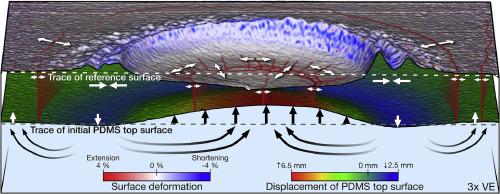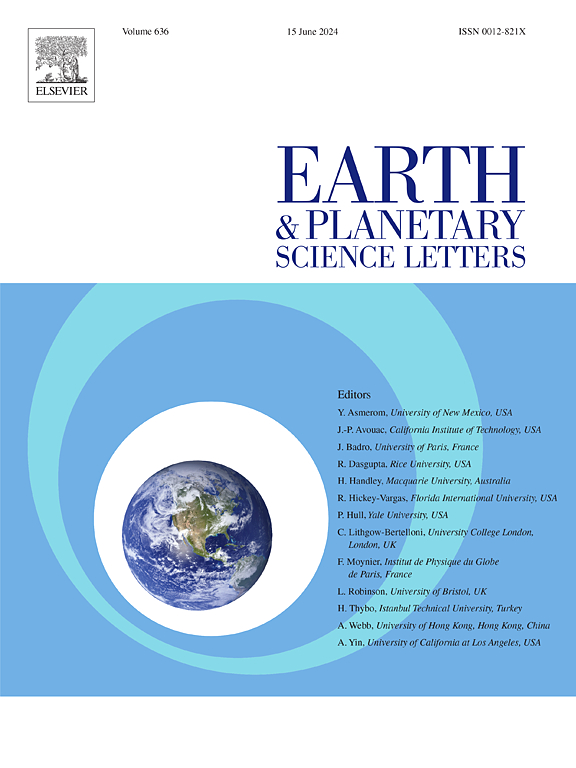大型陆地撞击结构的长期等静压松弛:从比例模拟实验中推断出的结构特征
IF 4.8
1区 地球科学
Q1 GEOCHEMISTRY & GEOPHYSICS
引用次数: 0
摘要
陨石坑底断裂是岩石天体上的大型撞击坑在塌陷后留下的突出结构遗迹。有两种机制可解释陨石坑底断裂的形成:一是陨石坑底水平火成岩片的置换;二是目标岩石下地壳的等静力再平衡,即地壳松弛。在这里,我们利用两层模拟实验来模拟陨石坑形成后下部和上部地壳的变形,模拟地球上的物理条件,以探索地壳松弛的结构和运动后果。具体地说,根据以前的平均大陆地壳数值模型,对陨石坑底的不同初始深度和直径,系统分析了模型上地壳的结构演变。模拟建模结果提供了上地壳变形区持续时间、几何形状和分布的定量估计,并首次提供了陨石坑底直径、深度和断裂几何形状之间的定量关系。实验还表明,陨石坑底部的隆起是通过陨石坑外围的长波沉降实现的,在自然界中,这种沉降的时间尺度可能长达数十万年。我们的结论是,天然陨石坑底部断裂的模式,包括萨德伯里和弗赖德福特撞击结构中已知的撞击熔岩堤,可能是由陨石坑底部的长期隆起造成的,并由流向陨石坑中心的横向地壳流动进行补偿。本文章由计算机程序翻译,如有差异,请以英文原文为准。

Long-term isostatic relaxation of large terrestrial impact structures: structural characteristics inferred from scaled analogue experiments
Crater floor fractures are prominent post-cratering structural vestiges that are known from large impact craters on rocky celestial bodies. Two mechanisms have been proposed to explain the formation of crater floor fractures: emplacement of horizontal igneous sheets below crater floors and isostatic re-equilibration of crust underlying target rocks, i.e., crustal relaxation. Here, we use two-layer analogue experiments to model the deformation of lower and upper crust following crater formation, scaled to the physical conditions on Earth, to explore the structural and kinematic consequences of crustal relaxation. Specifically, the structural evolution of model upper crust was systematically analysed for various initial depths and diameters of crater floors, gleaned from previous numerical models for average continental crust. The analogue modelling results provide quantitative estimates of the duration, geometry and distribution of deformation zones in the upper crust and, for the first time, a quantitative relationship between the diameter, depth and fracture geometry of crater floors. The experiments also show that crater floor uplift is accomplished by long-wavelength subsidence of the crater periphery, which may operate on time scales of hundreds of thousands of years in nature. We conclude that patterns of natural crater floor fractures, including impact melt rock dikes known from the Sudbury and Vredefort impact structures, can be caused by long-term uplift of the crater floor, compensated by lateral crustal flow toward the crater centre.
求助全文
通过发布文献求助,成功后即可免费获取论文全文。
去求助
来源期刊

Earth and Planetary Science Letters
地学-地球化学与地球物理
CiteScore
10.30
自引率
5.70%
发文量
475
审稿时长
2.8 months
期刊介绍:
Earth and Planetary Science Letters (EPSL) is a leading journal for researchers across the entire Earth and planetary sciences community. It publishes concise, exciting, high-impact articles ("Letters") of broad interest. Its focus is on physical and chemical processes, the evolution and general properties of the Earth and planets - from their deep interiors to their atmospheres. EPSL also includes a Frontiers section, featuring invited high-profile synthesis articles by leading experts on timely topics to bring cutting-edge research to the wider community.
 求助内容:
求助内容: 应助结果提醒方式:
应助结果提醒方式:


